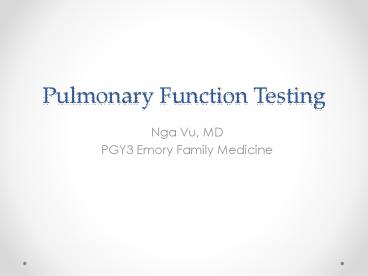Pulmonary Function Testing - PowerPoint PPT Presentation
1 / 30
Title:
Pulmonary Function Testing
Description:
Pulmonary Function Testing Nga Vu, MD PGY3 Emory Family Medicine PFTs Indications for Pulmonary Function Testing Patients 45 years old and older who have ever smoked. – PowerPoint PPT presentation
Number of Views:970
Avg rating:3.0/5.0
Title: Pulmonary Function Testing
1
Pulmonary Function Testing
- Nga Vu, MD
- PGY3 Emory Family Medicine
2
PFTs
3
Indications for Pulmonary Function Testing
- Patients 45 years old and older who have ever
smoked. - Patients with prolonged or excessive cough or
sputum production. - Patients with a history of exposure to lung
irritants.
4
Indications for Pulmonary Function Testing
- Assessing disease severity and progression
- Pulmonary disease COPD, Cystic fibrosis,
Interstitial lung disease, Sarcoidosis - Cardiac disease CHF, Congenital heart disease,
Pulmonary hypertension - Neuromuscular disease Amyotrophic lateral
sclerosis, Guillain-Barre syndrome, Multiple
sclerosis, Myasthenia gravis
5
Indications for Pulmonary Function Testing
- Detecting pulmonary disease
- Pulmonary symptoms chest pain, orthopnea,
cough, phlegm production, dyspnea, wheezing - Physical findings Chest wall problems,
cyanosis, clubbing, decreased breath sounds - Abnormal labs/x-rays ABG, Chest X-Ray
6
Indications for Pulmonary Function Testing
- Pre-operative risk stratification
- Evaluating disability and impairment
Barreiro TJ and Perillo, I. An Approach to
Interpreting Spirometry, AFP, March 1, 2004 69
1107-14.
7
Actual PFT Performance Technique
- The patient needs to practice the exercise before
actually performing the test. Have the patient
breath in and out deeply several times. - Ask the patient to breath in as deeply as they
can. - The patient should place their mouth completely
over the mouthpiece, not inside it. - Ask the patient to blow out as fast and as quick
as they can for at least six seconds. - Repeat the whole test three times. The goal is
to get a reproducible result that is consistent.
8
Normal Values
- FVC is the total amount of air a person can
exhale, usually measured in six seconds. - 80 120 of predicted is a normal value
- 70 80 demonstrates mild reduction/restriction
- 50 70 demonstrates moderate reduction
- lt50 demonstrates severe reduction
- FEV1 is the amount of air a person can exhale in
one second. - 80 120 of predicted is a normal value
9
Normal Values
- FEV1/FVC ratio is the percentage of FVC that can
be expired in one second. - 75 80 is normal
- 60 70 demonstrates mild obstruction
- 50 60 demonstrates moderate obstruction
- lt50 demonstrates severe obstruction
10
Normal Values
- FEF25-75 reflects small airway function
- gt80 is normal
- 60 80 reflects mild obstruction in the small
airways - 40 60 reflects moderate obstruction
- lt40 reflects severe obstruction
11
PFT Interpretation
- Assess FVC, FEV1, and FEV1/FVC ratio.
- FVC and FEV1 normal, with a normal FEV1/FVC
ratio - Normal Test yeah!!!
- FVC decreased, FEV1 low or normal, and a normal
to high FEV1/FVC ratio - Restrictive lung disease
- FVC normal or low, FEV1 low, and a low FEV1/FVC
ratio - Obstructive lung disease
12
Normal
Actual Predicted Predicted FVC 4.0 4.5 88
FEV1 3.4 4.2 89 FEV1/FVC 85 82 112 FEF25-75
13
Restrictive Pattern
Actual Predicted Predicted FVC 2.0 4.0 50
FEV1 1.8 3.7 47 FEV1/FVC 90 82 112 FEF25-75
14
Obstructive Pattern
Actual Predicted Predicted FVC 4.0 4.5 88
FEV1 2.4 4.2 58 FEV1/FVC 60 82 76 FEF25-75
2.2 4.4 50
15
Special Techniques
- Beta Agonist Challenge
- Methacholine Challenge
- DLCO
16
Beta Agonist Challenge
- Perform this when there is a suspicion that the
obstructive defect may be reversible gt asthma. - Give the patient a beta agonist treatment (two
puffs of an albuterol MDI or an albuterol
nebulizer) and repeat the PFTs several minutes
later. If you notice a 12 or more increase in
FEV1, then you have diagnosed reversible airway
disease/asthma. - A significant response to bronchodilator is
defined as a 12 AND 200 ml increment in EITHER
FEV1 or FVC.
17
Diffusion capacity of carbon monoxide in the lung
DLCO
- After performing the standard PFTs, the patient
then inhales trace amounts of carbon monoxide. - CO traverses the alveolar capillary beds much
more readily than CO2 or O2. - As such, most of the CO inhaled should be
absorbed. - When it is not, this suggests pulmonary scarring
consistent with pulmonary fibrosis. Search for a
cause.
18
Methacholine Challenge
- If you have a suspicion that the patient might
have exercise-induced bronchospasm (EIB), then
refer them to a pulmonary lab where they can do
provocative testing with methacholine. - If the patient has a decrease in their FEV1/FVC
ratio with the inhalation of methacholine, then
you have diagnosed EIB. - Pretreat before exercise with albuterol or
cromolyn.
19
Algorithm
20
Case 1
- Actual Predicted Predicted
- FVC 3.8 4.5 83
- FEV1 2.2 4.2 47
- FEV1/FVC 59 82 72
- FEF25-75 1.6 3.7 43
21
- COPD
22
Case 2
- Actual Predicted Predicted
- FVC 2.9 4.5 64
- FEV1 2.5 4.2 59
- FEV1/FVC 89 82 113
- FEF25-75 3.7 3.5 102
23
- Restrictive
24
Case 3
- Actual Predicted Predicted
- FVC 4.0 4.5 88
- FEV1 2.6 4.2 57
- FEV1/FVC 65 82 71
- FEF25-75 1.7 3.6 47
Beta agonist treatment
Actual Predicted Predicted FVC 4.1 4.5 91
FEV1 3.6 4.2 89 FEV1/FVC 90 82 112 FEF25-75 3
.2 3.6 91
25
- Reversible obstructive defect
- Asthma
26
Case 4
- Actual Predicted Predicted
- FVC 4.0 4.5 88
- FEV1 3.6 4.2 89
- FEV1/FVC 90 82 112
- FEF25-75 3.1 3.4 95
27
- Normal
28
Case 6
- Actual Predicted Predicted
- FVC 3.5 5.3 68
- FEV1 3.1 4.6 68
- FEV1/FVC 93 82 117
- FEF25-75 3.7 3.3 120
- Pts BMI is 47
29
- Restrictive pattern in obese patient
30
(No Transcript)































